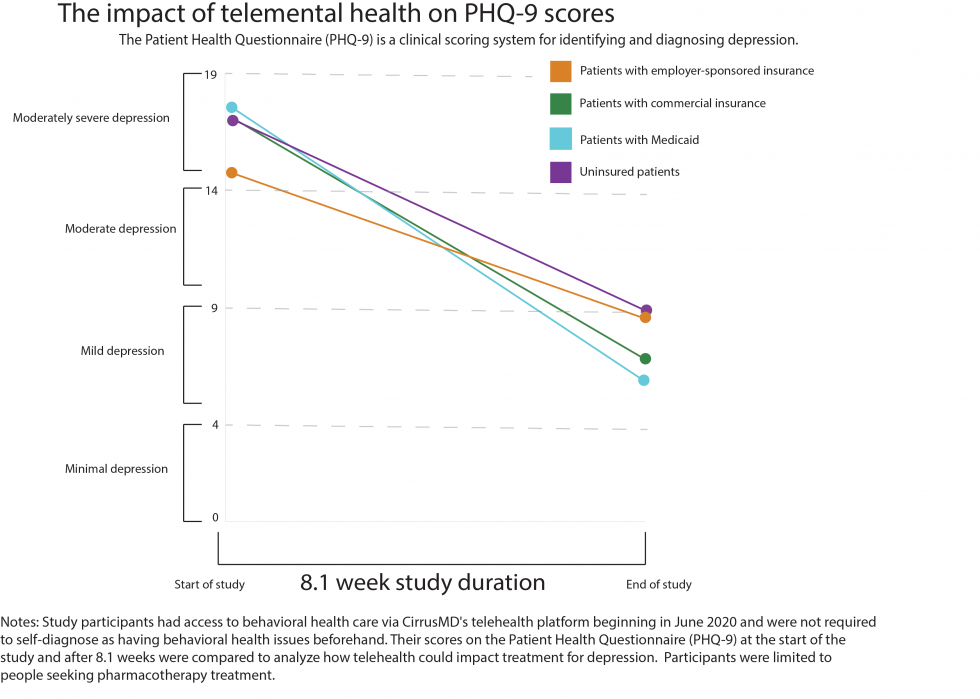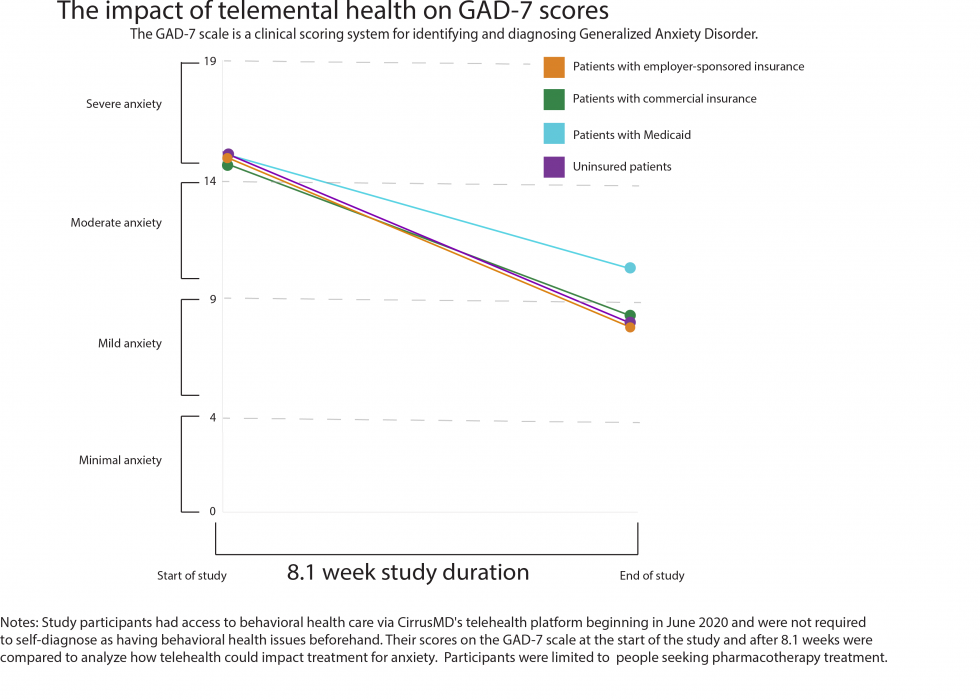
How telehealth can improve depression and anxiety outcomes
This story originally appeared on CirrusMD and was produced and distributed in partnership with Stacker Studio.
How telehealth can improve depression and anxiety outcomes
Americans’ mental health became collateral damage in the country’s fight against the COVID-19 virus—a more conspicuous physical enemy, perhaps, than anxiety or depression. At its peak over the last year and a half, more than 40% of adults reported anxiety or depression symptoms—four times the pre-pandemic rate.
But even in the decade before the emergence of the coronavirus, Americans were becoming more anxious and depressed. According to 2018 data collected by Blue Cross Blue Shield, major depression was the second most impactful health condition for commercially insured Americans, second only to high blood pressure. Between 2008 and 2018, anxiety became more prevalent across nearly all demographic subgroups, suggesting serious deficiencies in both cultural attitudes toward mental health, and access to the health care systems meant to protect an individual's overall wellbeing.
Social isolation, worry over economic stability and physical health, grief, fear, and uncertainty about the future are just some of the factors exacerbating depression and anxiety symptoms for many Americans. With the increasing prevalence of these behavioral health concerns across the population, the U.S. is also experiencing a shortage of mental health professionals to meet the rising demand.
According to a 2020 report by the Kaiser Family Foundation, more than 119 million Americans live in regions designated as mental health professional shortage areas, or HPSAs. Just over 25% of the need for mental health professionals is being met nationally.
Telehealth services are one emergent adaptation with staying power beyond the scope of the pandemic that can address this critical need at a more affordable cost. In a 2021 analysis, McKinsey found that telehealth utilization, across all medical services, increased 38 times from the pre-pandemic baseline. Of 23 medical specialities, psychiatry has the highest telehealth adoption rate with 50% of visits between April 2020 and February 2021 conducted virtually.
CirrusMD conducted a physician-led study to better understand how telemental health services can affect depression and anxiety outcomes. Study participants had access to behavioral health care via CirrusMD's telehealth platform beginning in June 2020 and were not required to self-diagnose as having behavioral health issues beforehand. The study was conducted over six months, with individual patients treated for an average of 8.1 weeks to analyze how telehealth could impact treatment for depression and anxiety. Patients' scores are captured through the Patient Health Questionnaire (PHQ-9) and the Generalized Anxiety Disorder Scale (GAD-7). Participants were limited to people seeking pharmacotherapy treatment. Diagnoses scores from the PHQ-9 and the GAD-7 are clinically recognized.
The PHQ9 assesses symptom severity based on total score where 5, 10, 15, and 20 are thresholds of mild, moderate, moderately severe, and severe depression, respectfully. The GAD7 assesses symptom severity based on total score of 5, 10, and 15, representing mild, moderate and severe symptoms, respectfully. Patient outcomes were determined to be clinically significant if the patient experienced a 5-point or greater reduction in either score.
Read on to learn more about the outcomes of CirrusMD’s telemental health treatment of anxiety and depression in participants with various forms of insurance coverage. Charts have been included at the end of the piece that capture the findings of the study.

Participants with commercial insurance
- Reduction in PHQ-9 scores after six months: 10.5 (clinically significant)
--- Initial PHQ-9 score, average: 17.27 (moderately severe)
--- PHQ-9 score after treatment, average: 6.77 (mild)
- Reduction in GAD-7 scores after six months: 6.42 (clinically significant)
--- Initial GAD-7 score, average: 14.71 (severe)
--- GAD-7 score after treatment, average: 8.29 (mild)
Commercial insurance participants experienced a clinically significant reduction in both depression and anxiety scores and the greatest PHQ-9 score reduction of any insurance group. The average PHQ-9 score among commercially insured participants after six months of telehealth treatment is 6.77, indicating partial remission—or a final PHQ-9 score below 10—and improvement of symptom categorization from severe to mild. Roughly 10% of Americans have commercial insurance, also referred to as private, direct-purchase, and non-group insurance. Commercial plan holders typically either do not qualify for public programs like Medicaid, cannot receive insurance through their employer, or require insurance not offered through other available channels.

Participants with Medicaid
- Reduction in PHQ-9 scores after six months: 11.91 (clinically significant)
--- Initial PHQ-9 score, average: 17.72 (moderately severe)
--- PHQ-9 score after treatment, average: 5.81 (mild)
- Reduction in GAD-7 scores after six months: 4.83 (scores above 5 are considered clinically significant)
--- Initial GAD-7 score, average: 15.09 (severe)
--- GAD-7 score after treatment, average: 10.26 (moderate)
At 17.72, Medicaid users had the highest average initial PHQ-9 scores, expressing moderately severe to severe symptoms of depression. After telehealth treatment, and concurrent pharmacotherapy, participants saw a clinically significant decrease in PHQ-9 scores. Medicaid holders did not see meaningful results from telehealth treatment for anxiety, missing the 5-point reduction threshold to be considered clinically significant. Just under 20% of the population is covered by Medicaid, according to the U.S. Census Bureau. This public health insurance program provides affordable coverage and critical health care access to some of the most vulnerable populations, including those over age 65, low-income families, and people with disabilities.

Uninsured participants
- Reduction in PHQ-9 scores after six months: 8.32 (clinically significant)
--- Initial PHQ-9 score, average: 17.21 (moderately severe)
--- PHQ-9 score after treatment, average: 8.89 (mild)
- Reduction in GAD-7 scores after six months: 7.16 (clinically significant)
--- Initial GAD-7 score, average: 15.142 (severe)
--- GAD-7 score after treatment, average: 7.982 (mild)
Uninsured participants improved from exhibiting moderately severe-severe depression symptoms to mild symptoms over the course of the study. The group saw clinically significant reductions in both depression and anxiety scores. As of 2019, roughly 29 million people in the United States were uninsured, citing prohibitive costs and registration barriers. Due to a lack of affordable care options, uninsured individuals— many of the same demographic subgroups at risk of developing mental health disorders—will not seek out preventative or follow-up care. Telehealth companies have the potential to greatly improve access to critical mental health resources for those who need it most, like uninsured populations.

Participants with employer-sponsored insurance
- Reduction in PHQ-9 scores after six months: 6.33 (clinically significant)
--- Initial PHQ-9 score, average: 14.85 (moderately severe)
--- PHQ-9 score after treatment, average: 8.52 (mild)
- Reduction in GAD-7 scores after six months: 7.18 (clinically significant)
--- Initial GAD-7 score, average: 14.99 (severe)
--- GAD-7 score after treatment, average: 7.81 (mild)
Employer-sponsored insurance participants saw clinically significant improvement of both anxiety and depression symptoms over the course of the study. According to the U.S. Census Bureau, roughly 55% of the population is covered by employer-sponsored insurance, or ESI. Limited by employers’ one-size-fits-all offerings, people with ESI may face greater difficulty finding adequate in-network care to treat behavioral disorders like anxiety or depression. Some even posit that ESI will lose its prevalence in the marketplace as more workers seek out insurance coverage prioritizing customization and flexibility.
Many of the findings around telehealth have significantly impacted those with anxiety and depression. While telehealth is a newer and less traditional form of medical care, it opens up the possibilities for greater accessibility. Between the COVID-19 pandemic, access to reliable transportation, and other accessibility barriers, telehealth can be a life-changing option for those suffering from anxiety and/or depression.

Chart 1

Chart 2



